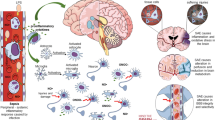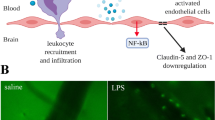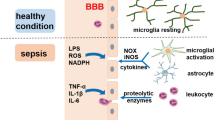Abstract
Sepsis, the host’s reaction to infection, characteristically includes multi-organ dysfunction. Brain dysfunction is often one of the first clinical symptoms in sepsis and may manifest as sepsis-associated delirium in up to 70 % of patients [1, 2], less often as focal deficits or seizures [3]. As severely reduced global perfusion leading to hypotension, maldistribution of regional blood flow, and tissue hypoperfusion is a key feature of severe sepsis and septic shock, the question whether there is a link between cerebral perfusion and brain dysfunction in sepsis is obvious. However, clinical and experimental data on cerebral perfusion in sepsis are often inconsistent and most reports only include small numbers of animals or patients. We summarize the current literature on the effects of the inflammatory response on cerebral perfusion and review the effects of altered cerebral perfusion on brain function in sepsis.
Access this chapter
Tax calculation will be finalised at checkout
Purchases are for personal use only
Preview
Unable to display preview. Download preview PDF.
Similar content being viewed by others
References
Pytel P, Alexander JJ (2009) Pathogenesis of septic encephalopathy. Curr Opin Neurol 22: 283–287
Papadopoulos MC, Davies DC, Moss RF, Tighe D, Bennett ED (2000) Pathophysiology of septic encephalopathy: a review. Crit Care Med 28: 3019–3024
Nagaratnam N, Brakoulias V, Ng K (2002) Multiple cerebral infarcts following septic shock. J Clin Neurosci 9: 473–476
Sharshar T, Annane D, de la Grandmaison GL, Brouland JP, Hopkinson NS, Francoise G (2004) The neuropathology of septic shock. Brain Pathol 14: 21–33
Siami S, Annane D, Sharshar T (2008) The encephalopathy in sepsis. Crit Care Clin 24: 67–82
Roth J, Harre EM, Rummel C, Gerstberger R, Hubschle T (2004) Signaling the brain in systemic inflammation: role of sensory circumventricular organs. Front Biosci 9: 290–300
Sharshar T, Gray F, Lorin de la Grandmaison G, et al (2003) Apoptosis of neurons in cardio vascular autonomic centres triggered by inducible nitric oxide synthase after death from septic shock. Lancet 362: 1799–1805
Wong ML, Bongiorno PB, Rettori V, McCann SM, Licinio J (1997) Interleukin (IL) Ibeta, IL-1 receptor antagonist, IL-10, and IL-13 gene expression in the central nervous system and anterior pituitary during systemic inflammation: pathophysiological implications. Proc Natl Acad Sci USA 94: 227–232
Freyer D, Manz R, Ziegenhorn A, et al (1999) Cerebral endothelial cells release TNF-alpha after stimulation with cell walls of Streptococcus pneumoniae and regulate inducible nitric oxide synthase and ICAM-1 expression via autocrine loops. J Immunol 163: 4308–4314
Hofer S, Bopp C, Hoerner C, et al (2008) Injury of the blood brain barrier and up-regulation of icam-1 in polymicrobial sepsis. J Surg Res 146: 276–281
Papadopoulos MC, Lamb FJ, Moss RF, Davies DC, Tighe D, Bennett ED (1999) Faecal peritonitis causes oedema and neuronal injury in pig cerebral cortex. Clin Sci (Lond) 96: 461–466
Sharshar T, Hopkinson NS, Orlikowski D, Annane D (2005) Science review: The brain in sepsis-culprit and victim. Crit Care 9: 37–44
Ari I, Kafa IM, Kurt MA (2006) Perimicrovascular edema in the frontal cortex in a rat model of intraperitoneal sepsis. Exp Neurol 198: 242–249
Alexander JJ, Jacob A, Cunningham P, Hensley L, Quigg RJ (2008) TNF is a key mediator of septic encephalopathy acting through its receptor, TNF receptor-I. Neurochem Int 52: 447–456
Sharshar T, Carlier R, Bernard F, et al (2007) Brain lesions in septic shock: a magnetic resonance imaging study. Intensive Care Med 33: 798–806
Moncada S, Palmer RM, Higgs EA (1991) Nitric oxide: physiology, pathophysiology, and pharmacology. Pharmacol Rev 43: 109–142
Avontuur JA, Bruining HA, Ince C (1997) Nitric oxide causes dysfunction of coronary autoregulation in endotoxemic rats. Cardiovasc Res 35: 368–376
Szabo C (1995) Alterations in nitric oxide production in various forms of circulatory shock. New Horiz 3: 2–32
Marshall JJ, Wei EP, Kontos HA (1988) Independent blockade of cerebral vasodilation from acetylcholine and nitric oxide. Am J Physiol 255: H847–854
Booke M, Westphal M, Hinder F, Traber LD, Traber DL (2003) Cerebral blood flow is not altered in sheep with Pseudomonas aeruginosa sepsis treated with norepinephrine or nitric oxide synthase inhibition. Anesth Analg 96: 1122–1128
Bowton DL, Bertels NH, Prough DS, Stump DA (1989) Cerebral blood flow is reduced in patients with sepsis syndrome. Crit Care Med 17: 399–403
Maekawa T, Fujii Y, Sadamitsu D, et al (1991) Cerebral circulation and metabolism in patients with septic encephalopathy. Am J Emerg Med 9: 139–143
Pfister D, Schmidt B, Smielewski P, et al (2008) Intracranial pressure in patients with sepsis. Acta Neurochir Suppl 102: 71–75
Moller K, Strauss GI, Qvist J, et al (2002) Cerebral blood flow and oxidative metabolism during human endotoxemia. J Cereb Blood Flow Metab 22: 1262–1270
Matta BF, Stow PJ (1996) Sepsis-induced vasoparalysis does not involve the cerebral vasculature: indirect evidence from autoregulation and carbon dioxide reactivity studies. Br J Anaesth 76: 790–794
Thees C, Kaiser M, Scholz M, et al (2007) Cerebral haemodynamics and carbon dioxide reactivity during sepsis syndrome. Crit Care 11: R123
Terborg C, Schummer W, Albrecht M, Reinhart K, WeiHer C, Rother J (2001) Dysfunction of vasomotor reactivity in severe sepsis and septic shock. Intensive Care Med 27: 1231–1234
Bowie RA, O'Connor PJ, Mahajan RP (2003) Cerebrovascular reactivity to carbon dioxide in sepsis syndrome. Anaesthesia 58: 261–265
Smith SM, Padayachee S, Modaresi KB, Smithies MN, Bihari DJ (1998) Cerebral blood flow is proportional to cardiac index in patients with septic shock. J Crit Care 13: 104–109
Pfister D, Siegemund M, Dell-Kuster S, et al (2008) Cerebral perfusion in sepsis-associated delirium. Crit Care 12: R63
Steiner LA, Pfister D, Strebel SP, Radolovich D, Smielewski P, Czosnyka M (2009) Near-infrared spectroscopy can monitor dynamic cerebral autoregulation in adults. Neurocrit Care 10: 122–128
Ebersoldt M, Sharshar T, Annane D (2007) Sepsis-associated delirium. Intensive Care Med 33: 941–950
Sprung CL, Peduzzi PN, Shatney CH, et al (1990) Impact of encephalopathy on mortality in the sepsis syndrome. The Veterans Administration Systemic Sepsis Cooperative Study Group. Crit Care Med 18: 801–806
Eggers V, Schilling A, Kox WJ, Spies C (2003) [Septic encephalopathy. Diagnosis und therapy]. Anaesthesist 52: 294–303
Zauner C, Gendo A, Kramer L, et al (2002) Impaired subcortical and cortical sensory evoked potential pathways in septic patients. Crit Care Med 30: 1136–1139
Eidelman LA, Putterman D, Putterman C, Sprung CL (1996) The spectrum of septic encephalopathy. Definitions, etiologies, and mortalities. JAMA 275: 470–473
Strebel SP, Kindler C, Bissonnette B, Tschaler G, Deanovic D (1998) The impact of systemic vasoconstrictors on the cerebral circulation of anesthetized patients. Anesthesiology 89: 67–72
Pfister D, Strebel SP, Steiner LA (2008) Effects of catecholamines on cerebral blood vessels in patients with traumatic brain injury. Eur J Anaesthesiol Suppl 42: 98–103
Edvinsson L, Hardebo JE, MacKenzie ET, Owman C (1978) Effect of exogenous noradrenaline on local cerebral blood flow after osmotic opening of the blood-brain barrier in the rat. J Physiol 274: 149–156
Author information
Authors and Affiliations
Editor information
Editors and Affiliations
Rights and permissions
Copyright information
© 2010 Springer Science + Business Media Inc.
About this paper
Cite this paper
Burkhart, C.S., Siegemund, M., Steiner, L.A. (2010). Cerebral Perfusion in Sepsis. In: Vincent, JL. (eds) Intensive Care Medicine. Springer, New York, NY. https://doi.org/10.1007/978-1-4419-5562-3_39
Download citation
DOI: https://doi.org/10.1007/978-1-4419-5562-3_39
Publisher Name: Springer, New York, NY
Print ISBN: 978-1-4419-5561-6
Online ISBN: 978-1-4419-5562-3
eBook Packages: MedicineMedicine (R0)




